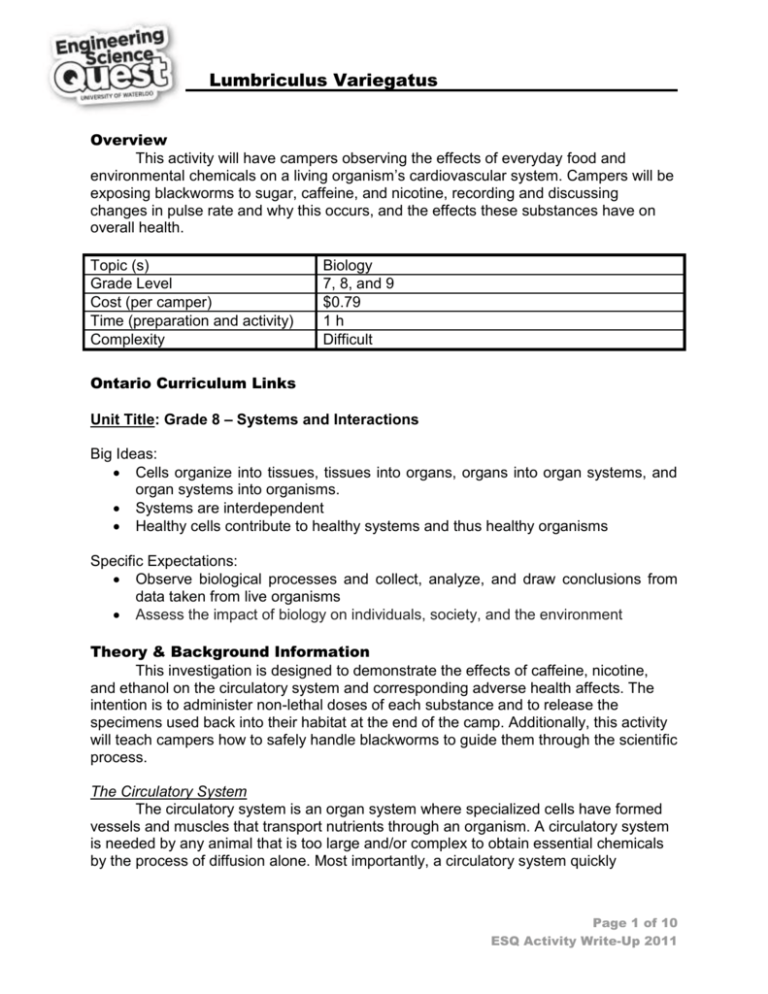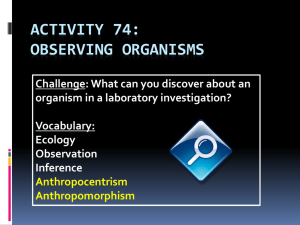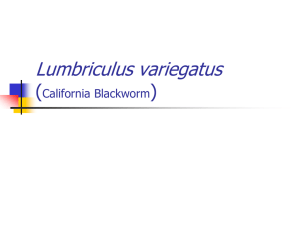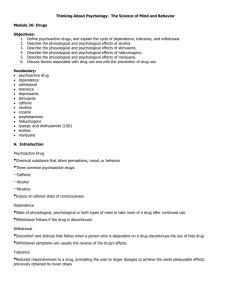20120313150216001
advertisement

Lumbriculus Variegatus Overview This activity will have campers observing the effects of everyday food and environmental chemicals on a living organism’s cardiovascular system. Campers will be exposing blackworms to sugar, caffeine, and nicotine, recording and discussing changes in pulse rate and why this occurs, and the effects these substances have on overall health. Topic (s) Grade Level Cost (per camper) Time (preparation and activity) Complexity Biology 7, 8, and 9 $0.79 1h Difficult Ontario Curriculum Links Unit Title: Grade 8 – Systems and Interactions Big Ideas: Cells organize into tissues, tissues into organs, organs into organ systems, and organ systems into organisms. Systems are interdependent Healthy cells contribute to healthy systems and thus healthy organisms Specific Expectations: Observe biological processes and collect, analyze, and draw conclusions from data taken from live organisms Assess the impact of biology on individuals, society, and the environment Theory & Background Information This investigation is designed to demonstrate the effects of caffeine, nicotine, and ethanol on the circulatory system and corresponding adverse health affects. The intention is to administer non-lethal doses of each substance and to release the specimens used back into their habitat at the end of the camp. Additionally, this activity will teach campers how to safely handle blackworms to guide them through the scientific process. The Circulatory System The circulatory system is an organ system where specialized cells have formed vessels and muscles that transport nutrients through an organism. A circulatory system is needed by any animal that is too large and/or complex to obtain essential chemicals by the process of diffusion alone. Most importantly, a circulatory system quickly Page 1 of 10 ESQ Activity Write-Up 2011 Lumbriculus Variegatus transports nutrients, oxygen, and other important chemicals to all body cells. Circulatory systems have three components: circulating fluid (i.e. blood), a heart or pulsating vessel which pumps the fluid, and vessels through which the fluid travels. The circulatory system works together with the endocrine system, which releases biological signals called hormones, and the nervous system to allow for circulation and pumping blood through muscle contraction or pulsation. There are two types of circulatory systems, closed and open. Open circulatory systems have vessels that are open at one end allowing fluid to flow out among the cells (found in mollusks and arthropods). In a closed circulatory system, the fluid is called blood and this blood remains within the vessels as it rapidly circulates the body (found in vertebrates (i.e. humans) and some worm species). Lumbriculus Variegatus (Blackworm) Blackworm is the common name for Lumbriculus variegatus, a freshwater worm. Blackworms can be found naturally in stagnant water along edges of marshes and ponds where they feed on small living and decaying organisms. Blackworms are small worms, ranging from 4-10cm in length. Blackworms have a closed circulatory system, which transports nutrients and oxygen using blood. The blackworm has a large dorsal (moving from the back) blood vessel that is very easy to see using a microscope. This blood vessel pumps oxygenated blood from the tail (which is usually kept towards the surface of water to take in oxygen) to the head of the worm by using rhythmic muscular contractions. The blood returns to the back end of the tail via a ventral (moving from the front) blood vessel, which does not pulse and is connected to the initial blood vessel via smaller vessels. Because the rate of pulsation is easily seen and calculated and some chemicals can easily diffuse through the worm’s thin skin, it is easy to test the effects of exposure to different chemicals on the cardiovascular system of the blackworms. Blackworms (Lumbriculus variegatus) are excellent organisms for studying the circulatory system and the effects of different substances on this system because their skin is transparent making it easy to observe pulsation rates, substances quickly diffuse through the skin of blackworms thus providing immediate effects, and blackworms are easy to maintain in a laboratory. In blackworms, the dorsal (or ‘from the back’) blood vessel pumps oxygenated blood from the back to front end of the worm by muscular contractions. These contractions are controlled by the nervous and endocrine systems (which send electrical signals and hormones throughout the body) that are affected by substances that we consume. In this investigation, campers observe blackworm pulsation rates in normal conditions and observe how pulsation rate is affected by caffeine, nicotine, and alcohol. Caffeine is a naturally occurring substance that is sometimes added to food such as sugary drinks and sweet snacks. Caffeine is a stimulant, meaning it creates more electrical signals and hormones in the body that in turn will quicken the pulsation rate. Large and frequent amounts of caffeine can lead to addiction as well as unpleasant physical effects such as nervousness, twitching, headaches, irritability and anxiety. The Page 2 of 10 ESQ Activity Write-Up 2011 Lumbriculus Variegatus blackworms in this experiment may clump together and curl up frequently as a result of caffeine. Similarly, nicotine is a stimulant in low doses. When concentrations increase, however, the worms will slow down and straighten out. Ethanol, however, is a depressant. Depressants slow down the nervous and endocrine systems, which will slow the movement and energy level of an organism. Quickening of the pulse requires more muscle and nervous system involvement, which in turn requires more energy. Humans will feel depleted of energy once the effects of pulse-quickening substances wear off and they will require rest or food and water. Slowing the pulse results in a lack of motor control (control over the body and muscles) and can become hazardous. Campers will have learned about the scientific process and will conduct a miniinvestigation, including formulating a hypothesis, identifying a control, identifying independent and dependent variables, analyzing results, and drawing conclusions. Materials Per Group of 3 or 4: Petri dish 20 mL prepared nicotine solution Tape and marker 20 mL prepared caffeine solution 10 blackworms 20 mL prepared ethanol solution Pipette 20 mL aged tap water /spring water Specimen slide Per Camper: Nitrile gloves Safety goggles Per Camp: At least 50 cultured blackworms Fish food At least 120 mL nicotine, caffeine, and ethanol solutions of desired concentrations Safety Concerns Safety Concern(s): Flammable/Combustible Material Poisonous/Infectious Materials (Immediate) Description: Ethanol Nicotine, caffeine, ethanol Applicable MSDS Ethanol Caffeine Nicotine Page 3 of 10 ESQ Activity Write-Up 2011 Lumbriculus Variegatus Risk Factors Some worms are weaker than others genetically and may die during the course of the experiment. Handle organisms with care. Do not use tap water with worms; the chlorine content is toxic to the blackworm. Use spring water or aged tap water. Addictive and harmful chemicals (nicotine, caffeine, and ethanol solutions) will be used. Do not ingest or allow coming in contact with skin. Nicotine Eyes: Immediately flush eyes with excess water for 15 minutes, lifting lower and upper eyelids occasionally. Skin: Immediately flush skin with excess water for 15 minutes while removing contaminated clothing. Ingestion: Call Poison Control immediately. Rinse mouth with cold water. Give victim 1-2 cups of water or milk to drink. Induce vomiting immediately. Inhalation: Remove to fresh air. If not breathing, give artificial respiration. Caffeine Eyes: Immediately flush eyes with excess water for 15 minutes, lifting lower and upper eyelids occasionally. Skin: Immediately flush skin with excess water for 15 minutes while removing contaminated clothing. Ingestion: Call Poison Control immediately. Rinse mouth with cold water. Give victim 1-2 cups of water or milk to drink. Induce vomiting immediately. Inhalation: Remove to fresh air. If not breathing, give artificial respiration. Ethyl alcohol Eyes: Immediately flush eyes with excess water for 15 minutes, lifting lower and upper eyelids occasionally. Skin: Immediately flush skin with excess water for 15 minutes while removing contaminated clothing. Ingestion: Call Poison Control immediately. Aspiration hazard. Rinse mouth with cold water. Give victim 1-2 tbsp of activated charcoal mixed with 8 oz water. Inhalation: Remove to fresh air. If not breathing, give artificial respiration. Location B1 laboratory room Page 4 of 10 ESQ Activity Write-Up 2011 Lumbriculus Variegatus Emergency Contingency Preventative 1. Culturing blackworms and handling them with care will prevent undue casualty. See Safety Considerations. 2. Leftover living worms can be disposed of naturally in stagnant water along edges of marshes and ponds. Reactive 1. In the event of blackworm casualty during transfer or substance administration, dispose of the worms as biological waste. 2. In the event of nicotine, caffeine, or ethanol skin contact, ingestion, etc., see attached MSDS information. Procedure Preparations 1. Worms should be bought and cultured 2-4 weeks prior to experiment. 2. If additional worms are needed, cut/fragment existing worms at least 24 hours ahead of time. 3. Prepare 150 mL of nicotine, caffeine, and ethanol solutions of desired concentrations in advance. Introduction 1. Introduce biology as the study of living organisms. Ask about different types of biological systems (circulatory, digestive, reproductive, nervous, etc.). 2. Discuss biological testing, animal testing, and the purpose of non-lethal ministrations and testing for gain of knowledge. 3. Introduce the circulatory system. Ask what it’s purpose is? (To transport nutrients from food and oxygen through an organism). a. There are open and closed circulatory systems. An open system has open vessels that allow fluids to flow into the body. Ask for examples (mollusks, anthropods). A closed system has closed vessels with blood that runs through to circulate the body. Ask for examples of closed circulatory systems (humans, worms). 4. Ask the meaning of Lumbriculus Variegatus? (Blackworm). a. Blackworms are freshwater worms, found naturally in water along edges of marshes and ponds. They eat small living and decaying organisms. They are 4 – 10 cm long. b. They have a closed circulatory system with a dorsal vessel that carries oxygenated blood through the body and a ventral vessel that circulates deoxygenated blood back. Ask what dorsal and ventral vessels are? (Travelling from back to front and front to back, respectively). Relate this to veins and arteries carrying oxygenated blood from the lungs to heart Page 5 of 10 ESQ Activity Write-Up 2011 Lumbriculus Variegatus and through the body, and from the body back to the heart and through the lungs again. c. The blood circulates through the body via muscle contractions controlled by the nervous and endocrine systems. These systems are affected by substances in the body, and these effects can be seen in the change in pulsation rate. d. Blackworms are ideal for observing pulsation rates because they have transparent skin, substances diffuse into them quickly and easily, and the main blood vessel is visible. 5. Ask if the kids know what stimulants and depressants are? We will be testing the blackworms with caffeine, nicotine, and ethanol. Ask where these substances are found (coffee, candy, cigarettes, alcoholic beverages). a. Caffeine and nicotine are natural stimulants. They cause more electrical signals and a release of more hormones in the body that in turn quicken the pulse and bodily movement. Depressants, like alcohol (we are using ethanol) do the opposite: they slow down the electrical and hormonal signals, slowing the heart rate and movement in the body. b. Quickening of the pulse drains the body of energy and requires more frequent eating and rest. Slowing of the pulse inhibits motor control (being able to control movement of the body) and can become quite hazardous. 6. Ask campers to make predictions on the pulse rate and movement of the blackworms in each solution. Activity 1. Obtain four petri dishes and label them Water, Nicotine, Caffeine, and Ethanol. 2. Carry the petri dish labeled Water to the tank of worms and, using a pipette, suck up 30 worms and place them in the dish. 3. Once back at your lab table, place two toothpicks side by side (parallel to each other) on a specimen slide. Remove one worm with the pipette and place it gently on the slide between the toothpicks to keep the worm still. Be careful not to injure the worm. 4. Using a magnifying glass, watch the middle section of the worm and count how many pulses pass in 30 seconds. Multiply this by 2 to get the pulses per minute and record it in your observation chart (See attached chart). Return the first worm to the water dish and repeat this procedure with two other worms. Add up the three pulses per minute recorded and divide by 3 to gain an average. 5. After the three worms have been replaced, have one group member take the pipette and put 10 worms into each of the dishes labeled Nicotine, Caffeine, and Ethanol. 6. As this is happening, have another group member retrieve 20 mL of nicotine, 20 mL of caffeine and 20 mL of ethanol solutions using a graduated cylinder. Be sure to rinse the cylinder with water between solutions. Pour the solution into the Page 6 of 10 ESQ Activity Write-Up 2011 Lumbriculus Variegatus correctly labeled dishes. The worms should be mostly submerged in the liquid. If they are not, put another 10 mL of solution in the dish. 7. Observe the worms in each solution for 20 minutes, recording any changes in your Observations section (i.e. if the worms curl and stretch more, if they become more straight and motionless, etc.). 8. After 20 minutes, repeat step 4 with three worms from each dish. Record the new pulsation rate results in your table. 9. Discuss the questions on the laboratory handout with your group members and with the whole camp once everyone has completed. 10. Draw conclusions. Are nicotine, caffeine, and alcohol stimulants or depressants? What does this mean? (Stimulate system, higher pulse. Depress system, slower pulse). Could prolonged exposure to these kinds of substances cause health risks? (Yes. Addiction, dependency, strain on major organ systems, altering of natural hormone function, etc.) 11. Dispose of the test solutions in the lab sink while the water is running. Activity Accommodations and Extensions Accommodations Each group can have one solution as opposed to three and the group can collaborate on their findings. As well, average pulsations are taken to avoid testing a worm that is weaker than others (poor representation) and can be skipped. Extensions A sugar solution can be tested as well. Additionally, changing the concentrations of each solution. Safety Considerations Nicotine, caffeine, and ethanol will be present in pure form. They should not be ingested or touched with bare skin. If treatment is required, refer to attached MSDS information. Culturing Blackworms Fill a bucket, small aquarium, or large finger bowl with 2-3 inches of aged, dechlorinated water (or spring water). Add healthy worms (about 100) to the water and then layer the water with several small pieces of brown paper towel. Every week add one to two (depending on size of aquarium) pellets of sinking fish food. Do not overfeed! As water evaporates, add spring water to the original level. When the water begins to appear cloudy and/or starts to stink, slowly pour off as much of the water as possible without losing the paper towel pieces or the worms. Rinse the worms and paper towel once (with aged water) and then refill the aquarium (to 2-3 inches) with fresh water and a few new pieces of brown paper towel. If you are not using the worms for a while, split the culture or feed some of the extra worms to fish (the culture should double every 2-3 Page 7 of 10 ESQ Activity Write-Up 2011 Lumbriculus Variegatus weeks and more quickly with slight agitation). This culture should live for a long time following these procedures. Handling Blackworms Worms are best handled by sucking them up with a plastic disposable pipet. Blow out the air in a pipette, place the pipette at a 45 degree angle, lower it to the bottom, and quickly suck up 1 or 2 worms at their head ends. If you dismember any of the worms in the process, just leave the pieces in the culture to regenerate. Templates Attached: Lumbriculus Variegatus Investigation Safety Templates MSDS sheets attached: Ethanol, nicotine, caffeine. Resources Effects of Drugs on Pulsation Rate of Lumbriculus Variegatus (Blackworms), http://www.ableweb.org/volumes/vol-27/07_Bohrer.pdf Page 8 of 10 ESQ Activity Write-Up 2011 Lumbriculus Variegatus Investigation Outline Purpose The purpose of this experiment is to _________________________________________ ______________________________________________________________________ ______________________________________________________________________. Predictions (Fill in blanks with stimulating/depressing/none) It is predicted that the nicotine will have a ________________________ effect. It is predicted that the caffeine will have a ________________________ effect. It is predicted that the ethanol/alcohol will have a __________________ effect. Observations Quantitative Observations: Table 1: Pulsation Rates in Tested Blackworms Before and After Solution Exposure Worm # Pulsation Rate per Minute before Solution Exposure (Pulses per minute) Pulsation Rate per Minute after Solution Exposure (Pulses per minute) 1 2 3 Average Qualitative Observations: Describe any changes in movement or shape of the blackworms during the time in each solution. ______________________________________________________________________ ______________________________________________________________________ ______________________________________________________________________ ______________________________________________________________________ ______________________________________________________________________ Discussion 1) Why was more than one work used for each solution? Did the worms in the same solution act differently? 2) Did the pulsation rates change from before and after any of the solutions? Why or why not? 3) If someone were to take these substances every day for years of their life, do you think there would be any health risks? Page 9 of 10 ESQ Activity Write-Up 2011 Lumbriculus Variegatus Conclusions _________________________________________________________ ______________________________________________________________________ ______________________________________________________________________ _____________ Page 10 of 10 ESQ Activity Write-Up 2011







